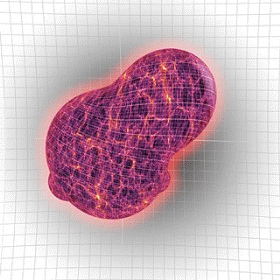
Dark Energy |
|
We are truly blessed to be living in an epoch of discoveries piling on discoveries in science, medicine, even in human affairs. One of the interesting things about real discoveries is that they always tend to confirm or tend to disprove the prevailing paradigm—a construct of the social imagination about the subject. Paradigms are complex mental constructions that because of their premises, postulates, and hypotheses accept certain kinds of evidence and ignore other kinds. Paradigms set (or are sets of) direct and analogical rules about their subjects and act very much like Gestalt phenomena. Paradigms, being social phenomena, shift like tectonic plates ... only under great pressure and fairly suddenly ... often with very kinetic and powerful results.
Many people who have read Thomas Kuhn's seminal work The Structure of Scientific Revolutions believe they have seen paradigms come and go in all sorts of fields of human enterprise ... and perhaps they have. Paradigms are usually quite big and balky mental constructs, more like icebergs, nine tenths unseen, but nevertheless felt. It is unlikely that most people have seen anything like the Copernican Revolution, where the earth was removed from the center of the universe to be replaced by our sun and then a few centuries later the center of our galaxy and then more recently by we know not what exactly—a mathematical abstraction about the nature of our particular expanding (perhaps bubble) universe.
Our common senses tell us that the sun rises and the sunsets, that is, that the sun moves while we in Kansas or Moscow or Nairobi remain in our place. It takes the drawing of a diagram or making of a model of the heliocentric system to fully appreciate how our senses are deceived by the simplest explanation of rising and setting, and you should know that it takes piles of confirming evidence to build up the social and enterprise courage to make such a model or draw such a picture.
Just so. In Scientific American Magazine this month (April, 2009) there is a very interesting article for which I have been waiting for months and months (since I first heard about this idea from a friend in San Francisco) about whether there really is dark energy in our universe. The very interesting thing about this article to me is the explicit tentativity of the authors, the respectful hesitancy about the glaring problem that continues in cosmology and physics, if the thesis they are expounding turns out to be falsifiable and wrong, namely that 70% of the energy of our universe is detectable only through intelligent inference, which normally is woefully insufficient as a methodology in science. One posits genes and then one actually finds and describes and manipulates them. One posits quarks and then one builds huge particle accelerators in the Alps and finds them ... or not. If not, then abandoning the hypothesis.
(There is, by the way, a short video about this online, in case you want explain this to your budding scientists.)
The thesis of the SciAm article is that all the talk about "dark energy" (which is hypothesized to be 70% of all the energy in the universe and undetectable, unobservable ... except by inference) might be explained by a simpler and yet messier idea about voids or semi-voids in the universe. In other words, if you postulate that the stuff of the universe—the space-time continuum—is like a great swiss cheese, complete with gargantuan areas of much lesser density than the average of the universe, the whole matter of "dark energy" goes away ... under certain circumstances, which are either probable or not depending on your tendency to cling to the dark energy hypothesis or not. Remember, dark energy according to the prevailing hypothesis is 70% of the energy in the universe, that is, a very considerable concept!
It is interesting to note how reluctant the authors of the article are to actually challenge the alternative to their hypothesis, that the glaringly large elephant in the room is an hypothesis about an energy in the universe which we cannot experience, but only infer (and only infer it because of observations at least as parochially commonplace and potentially deceiving as watching the "rising" and "setting" sun). It seems to me that we are exactly at that point in a paradigm shift where the full set of preceding assumptions of the prevailing paradigm—the so-called Cosmological Principle of Universal Homogeneity—is slowly being bared to the light, right in front of our blinking eyes. There is no more reason to prefer homogeneity than to prefer the sun in the center of the galaxy. The assumption the authors are "afraid" to state aloud is the assumption that eventually physics will find "dark energy" and experience it directly ... because (silent, enthymeistic hypothesis) science has been so successful so far.
Well not always.
Yes, the authors do bring it up, but they are careful not to rub it in the faces of the powers that be, which of course include Editor Rennie and their institutional and their professional colleagues, and you and me. I have to admit that my "take" on dark energy and dark matter, for that matter, is pretty much like my take on 19th c. "phlogiston." Phlogiston, for the uninitiated, was an hypothesis that an invisible and undetectable substance in space existed through which wave phenomena were propagated ... because, said the scientific moguls of the day, without a substance what would the waves be OF, anyway, certainly not seawater or air or amber grain.
The point of bringing this dark energy article to your attention is to point out a very interesting development in a scientific hypothesis, a phenomenon, which if it goes one way will result in an important paradigm shift. It seems to me, too of course, that there are other paradigms teetering on the edge these days and that this example from physics and cosmology is more than just instructive. It is chastening.
|
Rate It | View Ratings |
James R. Brett, Ph.D. taught Russian History before (and during) a long stint as an academic administrator in faculty research administration. His academic interests are the modern period of Russian History since Peter the Great, Chinese (more...)
The views expressed herein are the sole responsibility of the author
and do not necessarily reflect those of this website or its editors.

OpEdNews depends upon can't survive without your help.
If you value this article and the work of OpEdNews, please either Donate or Purchase a premium membership.
STAY IN THE KNOW
If you've enjoyed this, sign up for our daily or weekly newsletter to get lots of great progressive content.
If you've enjoyed this, sign up for our daily or weekly newsletter to get lots of great progressive content.
To View Comments or Join the Conversation:




